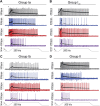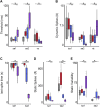Mechanosensory encoding dysfunction emerges from cancer-chemotherapy interaction
- PMID: 36504708
- PMCID: PMC9729348
- DOI: 10.3389/fmolb.2022.1017427
Mechanosensory encoding dysfunction emerges from cancer-chemotherapy interaction
Abstract
Persistent sensory, motor and cognitive disabilities comprise chemotherapy-induced neural disorders (CIND) that limit quality of life with little therapeutic relief for cancer survivors. Our recent preclinical study provides new insight into a condition impacting the severity of chronic CIND. We find that sensorimotor disability observed following cancer treatment exceeds that attributable to chemotherapy alone. A possible explanation for intensified disability emerged from evidence that codependent effects of cancer and chemotherapy amplify defective firing in primary sensory neurons supplying one type of low threshold mechanosensory receptor (LTMR). Here we test whether cancer's modification of chemotherapy-induced sensory defects generalizes across eight LTMR submodalities that collectively generate the signals of origin for proprioceptive and tactile perception and guidance of body movement. Preclinical study enabled controlled comparison of the independent contributions of chemotherapy and cancer to their clinically relevant combined effects. We compared data sampled from rats that were otherwise healthy or bearing colon cancer and treated, or not, with human-scaled, standard-of-care chemotherapy with oxaliplatin. Action potential firing patterns encoding naturalistic mechanical perturbations of skeletal muscle and skin were measured electrophysiologically in vivo from multiple types of LTMR neurons. All expressed aberrant encoding of dynamic and/or static features of mechanical stimuli in healthy rats treated with chemotherapy, and surprisingly also by some LTMRs in cancer-bearing rats that were not treated. By comparison, chemotherapy and cancer in combination worsened encoding aberrations, especially in slowly adapting LTMRs supplying both muscle and glabrous skin. Probabilistic modeling best predicted observed encoding defects when incorporating interaction effects of cancer and chemotherapy. We conclude that for multiple mechanosensory submodalities, the severity of encoding defects is modulated by a codependence of chemotherapy side effects and cancer's systemic processes. We propose that the severity of CIND might be reduced by therapeutically targeting the mechanisms, yet to be determined, by which cancer magnifies chemotherapy's neural side effects as an alternative to reducing chemotherapy and its life-saving benefits.
Keywords: cancer treatment; chemotherapy; cutaneous; neurotoxicity; proprioception; sensorimotor abnormalities; sensory encoding.
Copyright © 2022 Housley, Nardelli, Rotterman, Reed and Cope.
Conflict of interest statement
The authors declare that the research was conducted in the absence of any commercial or financial relationships that could be construed as a potential conflict of interest.
Figures







Similar articles
-
A novel path to chronic proprioceptive disability with oxaliplatin: Distortion of sensory encoding.Neurobiol Dis. 2016 Nov;95:54-65. doi: 10.1016/j.nbd.2016.07.004. Epub 2016 Jul 7. Neurobiol Dis. 2016. PMID: 27397106 Free PMC article.
-
Chronic defects in intraspinal mechanisms of spike encoding by spinal motoneurons following chemotherapy.Exp Neurol. 2020 Sep;331:113354. doi: 10.1016/j.expneurol.2020.113354. Epub 2020 Jun 5. Exp Neurol. 2020. PMID: 32511953 Free PMC article.
-
Complex impairment of IA muscle proprioceptors following traumatic or neurotoxic injury.J Anat. 2015 Aug;227(2):221-30. doi: 10.1111/joa.12312. Epub 2015 Jun 5. J Anat. 2015. PMID: 26047324 Free PMC article.
-
The specification and wiring of mammalian cutaneous low-threshold mechanoreceptors.Wiley Interdiscip Rev Dev Biol. 2016 May-Jun;5(3):389-404. doi: 10.1002/wdev.229. Epub 2016 Mar 17. Wiley Interdiscip Rev Dev Biol. 2016. PMID: 26992078 Free PMC article. Review.
-
Mechanosensory perception: are there contributions from bone-associated receptors?Clin Exp Pharmacol Physiol. 2005 Jan-Feb;32(1-2):100-8. doi: 10.1111/j.1440-1681.2005.04136.x. Clin Exp Pharmacol Physiol. 2005. PMID: 15730443 Review.
Cited by
-
Biophysical model of muscle spindle encoding.Exp Physiol. 2024 Jan;109(1):55-65. doi: 10.1113/EP091099. Epub 2023 Mar 26. Exp Physiol. 2024. PMID: 36966478 Free PMC article. Review.
-
Mechanosensory encoding in ex vivo muscle-nerve preparations.Exp Physiol. 2024 Jan;109(1):35-44. doi: 10.1113/EP090763. Epub 2023 Apr 29. Exp Physiol. 2024. PMID: 37119460 Free PMC article. Review.
-
Spinal cord stimulation attenuates paclitaxel-induced gait impairment and mechanical hypersensitivity via peripheral neuroprotective mechanisms in tumor-bearing rats.Reg Anesth Pain Med. 2025 Aug 5;50(8):675-684. doi: 10.1136/rapm-2024-105433. Reg Anesth Pain Med. 2025. PMID: 38844412
References
-
- Amos-Landgraf J. M., Kwong L. N., Kendziorski C. M., Reichelderfer M., Torrealba J., Weichert J., et al. (2007). A target-selected Apc-mutant rat kindred enhances the modeling of familial human colon cancer. Proc. Natl. Acad. Sci. U. S. A. 104 (10), 4036–4041. 10.1073/pnas.0611690104 - DOI - PMC - PubMed
LinkOut - more resources
Full Text Sources

